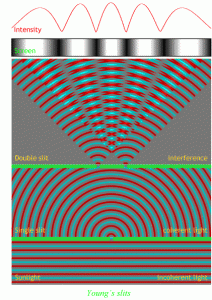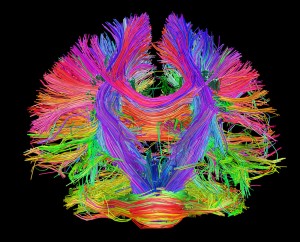Dec
30
2014
Living things move. In fact our visual system uses the way things move to decide whether or not an object has agency and is able to move on its own. In the pre-technological world only things that are alive have agency, but in the technological era we have animatronics and animated video that can mimic the movement of living things and trick our brains into treating objects or representations as if they are alive.
There are several applications for detecting the signatures of life. So far such efforts have focused mainly on chemical signatures – looking for the products of biochemistry. Researchers publishing in PNAS, however, have taken a new approach. They are trying to detect the motion signatures of life at a microscopic scale.
They use nanoscale motion detectors that are actually tiny cantilevers. Even a single bacterium twirling its flagella can cause the cantilever to move. Lasers then detect the motion of the cantilever, and that motion is analyzed for the signatures of life. The researchers tested their setup on soil and pond water, and found that it accurately detected microscopic life. They then used drugs to kill any living cells, and the detection stopped.
Continue Reading »
Dec
29
2014
New evidence suggests that strains of the bacterium, Bordetella pertussis, which is responsible for whooping cough, may be evolving to evade immune protection afforded by the pertussis vaccine.
The research, led by Dr Andrew Preston from the University of Bath, evaluated surface proteins from the 2012 whooping cough outbreak. They found that surface proteins that are included in the acellular pertussis vaccine were evolving faster than surface proteins not included in the vaccine. The authors point out that this was happening even prior to the introduction of the vaccine, but has accelerated since the vaccine.
It is not yet clear what, if anything, this means for the effectiveness of the acellular pertussis vaccine. However, the concern is that circulating strains of B. pertussis will continue to evolve, diminishing the protection provided by existing vaccines.
Whooping cough is a potentially serious illness, primarily affecting infants. There was an outbreak in the UK in 2012 with 10,000 confirmed cases and 14 infant deaths. In the US that same year there were over 48,000 cases reported (not necessarily confirmed) and 20 deaths.
Continue Reading »
Dec
25
2014
Seasons Greetings, Happy Holidays, Happy Festivus, Have a wonderful Winter Solstice, and Merry Christmas.
This is the time of year that many cultures in the northern hemisphere celebrate the return of the sun, celebrate family and life while facing the long dark of winter, and engage in superstitious rituals to help them survive the cold and hunger that mark that season. All of that is the real reason for the season.
In western culture the celebration has been largely “Christianized” into the holiday of Christmas, but the secular aspects of Christmas, from gift giving to the Christmas tree, all have non-Christian origins.
For me, though, it all doesn’t matter. It’s a great time of year to take a break from the usual grind and spend time with family and friends, reminding everyone how much we mean to each other. In the darkest part of the year (again, with apologies to my southern hemisphere friends) we spread a little light and warmth to those in our lives.
Continue Reading »
Dec
23
2014
 The press release of this news items proclaims: “Quantum physics just got less complicated.” I’m not sure I agree. Perhaps in the minds of physicists who actually understand quantum mechanics (as well as it currently can be understood). To the rest of us this new finding is just as strange and incomprehensible as QM itself.
The press release of this news items proclaims: “Quantum physics just got less complicated.” I’m not sure I agree. Perhaps in the minds of physicists who actually understand quantum mechanics (as well as it currently can be understood). To the rest of us this new finding is just as strange and incomprehensible as QM itself.
QM describes the universe at the atomic and subatomic levels. At that scale nature behave very differently from what we are used to at the macroscopic level, which is often referred to as the realm of classical physics. The dividing line between the quantum world and the classical world remains a matter of research and debate, but it is somewhere at the level of molecules.
There are several aspects to QM which essentially describe the results of careful experiments. We don’t currently have a proven theoretical framework to explain why the universe behaves this way – that is a breakthrough waiting to happen.
One aspect of QM is known as wave-particle duality. When particles, such as photons, shine through two narrow close slits (the famous double slit experiment) the pattern of light that hits the wall (or film or detector) behind the slits is in a light and dark banded pattern that resembles the interference pattern that results when two waves intersect. The light is clearly traveling as a wave through the two slit and those waves are interfering on the other side.
Continue Reading »
Dec
22
2014
 A recurring controversy that crops up from time to time within the rationalist communities is how to deal with someone who promotes rationalism on the one hand, but has a major flaw on the other. The latest example of this comes from my friend and colleague, Phil Plait.
A recurring controversy that crops up from time to time within the rationalist communities is how to deal with someone who promotes rationalism on the one hand, but has a major flaw on the other. The latest example of this comes from my friend and colleague, Phil Plait.
The IFLS website posted a picture of women actors who are also scientists. The image included Mayim Bialik, who plays Amy on the Big Bang Theory, and who also has a Ph.D. in neuroscience. At the same time, Bialik is openly anti-vaccine, and promotes pseudoscientfic organizations like Holistic Moms Network and Attachment Parenting International. Phil retweeted the picture from IFLS and added, “I love this.”
This all prompted another round of hand-wringing (actually I think this is all a healthy and interesting conversation) over supporting scientists, educators, and skeptics who are flawed in some way. Phil defends the position in his blog that we can accept flawed characters as ambassadors of science, writing:
So is using her in that montage of pictures a good thing or a bad thing? I would argue it’s neither, but the good outweighs the bad. The facts are that she is a scientist, she is an actress, and the picture was about actresses who are scientists. In point of fact, celebrities can be influential, and it’s a good thing that people see science supported by celebrity.
Other celebrities who have caused the same type of controversy include Bill Maher, who is an outspoken atheist, but who is also anti-vaccine, doubts the germ theory of disease, and has a general conspiratorial attitude toward modern medicine.
Continue Reading »
Dec
19
2014
An Australian based company called Universal Medicine (UM) has been criticized by various skeptical blogs and groups as being a new age alternative medicine cult. Looking through their website, this seems like a reasonable observation. (The term “cult” is fuzzy, but many of the features seem to be present.)
In response to this criticism, UM has apparently issued many complaints to Google, claiming defamation. According to the site Chilling Effect, Google has responded at least in some cases by removing the sites from Google searches, effectively censoring those websites.
Doubtful News was one of the sites censored by Google.
This type of action represents a serious threat to the skeptical mission. Part of that mission is consumer protection, and the primary method of activism is public analysis and criticism of dubious claims, products, services, and organizations. Essentially, we expose charlatans.
Charlatans, it turns out, don’t like to be exposed. They don’t like bad press.
Continue Reading »
Dec
18
2014
Egnor continues his dualist neuroscience denial in two follow up posts, mostly responding to PZ Myers’ take down of his original post. Egnor has also been writing separately about computers, arguing that they have no memory and will never be intelligent (have agency).
In all of these posts Egnor is following the same basic intellectual strategies – use words in a vague and confusing way to befuddle your reader, and assume your conclusion (dualism). Ironically, he writes:
The contemporary criticism of such phrases as “memory is stored in the brain” and “the brain evaluates propositions” and “the occipital cortex perceives images” — criticism made by neuroscientists and philosophers like Maxwell Bennett and Peter Hacker among others — is in keeping with the salient critiques by ordinary language philosophers who insist that we need to be honest and careful with the meanings of words in our scientific discourse. Ordinary language philosophy in neuroscience is an appeal to conceptual hygiene.
The projection is truly amazing. Science denial is pseudoskepticism – all of the form with none of the actual substance.
Continue Reading »
Dec
16
2014
 It has been six years since I have written a blog post deconstructing the nonsense of our favorite creationist neurosurgeon, Michael Egnor. In case you have forgotten, he is a dualist writing for the intelligent design propaganda blog, Evolution News and Views. He delights in ridiculing what he calls “materialist metaphysics,” or what scientists call, “science.”
It has been six years since I have written a blog post deconstructing the nonsense of our favorite creationist neurosurgeon, Michael Egnor. In case you have forgotten, he is a dualist writing for the intelligent design propaganda blog, Evolution News and Views. He delights in ridiculing what he calls “materialist metaphysics,” or what scientists call, “science.”
I guess I shouldn’t be surprised that he has managed to outdo his prior incoherent ramblings. In a recent blog post he claims that it is impossible for the brain to store memories, an idea he ridicules as “nonsense.”
As usual, Egnor is playing loose with definitions and logic, tying himself up in a conceptual knot in order to arrive at his desired destination – the idea that the brain cannot account for mental phenomena. His logic train derails pretty quickly:
It has been known for the better part of a century that certain structures in the brain are associated with memory. The amygdala and the hippocampus in the temporal lobe, and some adjacent cortical regions, have been shown to be associated with the act of remembering in animals and humans.
Continue Reading »
Dec
15
2014
 Even after a couple of decades as a skeptical activist I can still encounter new dark recesses festering with pseudoscience. The human capacity for nonsense seems endless.
Even after a couple of decades as a skeptical activist I can still encounter new dark recesses festering with pseudoscience. The human capacity for nonsense seems endless.
A report in an alternative news outlet from the American Institution of Alternative Archeology (AIAA – the tag “alternative” is a huge red flag) claims that the Smithsonian Institution “destroyed thousands of giant human remains during the early 1900′s.”
Why would they do this? The AIAA has an unconventional view of human history. Apparently based on mention in the bible that giants once walked the earth, they believe that the mound building cultures of the Americas were not the product of early Native Americans but rather an earlier race of technologically advanced giants. Reading the comments after the article, it also seems that the belief these giants were white and Aryan is popular.
This is an excellent example of how a narrative develops from a combination of religious beliefs and cultural biases, and then history is rewritten and conspiracy theories woven out of whole cloth in order to support the preferred narrative. Science and evidence do not guide the narrative, but rather it is the other way around – a hallmark of pseudoscience.
Continue Reading »
Dec
12
2014
 Occasional warnings about artificially intelligent robots taking over the world convulse through the media. There is currently a ripple involving prior interviews with Stephen Hawking and Elon Musk. Their names attract attention, and so the issue will provide a media distraction for a day or two.
Occasional warnings about artificially intelligent robots taking over the world convulse through the media. There is currently a ripple involving prior interviews with Stephen Hawking and Elon Musk. Their names attract attention, and so the issue will provide a media distraction for a day or two.
In an interview with the BBC, Hawking said:
“The development of full artificial intelligence could spell the end of the human race.”
“It would take off on its own, and re-design itself at an ever increasing rate. Humans, who are limited by slow biological evolution, couldn’t compete, and would be superseded.”
In an interview in June with CNBC, Elon Musk said:
“I think there’s things that are potentially dangerous out there. …There’s been movies about this, like ‘Terminator.’ There’s some scary outcomes and we should try to make sure the outcomes are good, not bad.”
Continue Reading »











